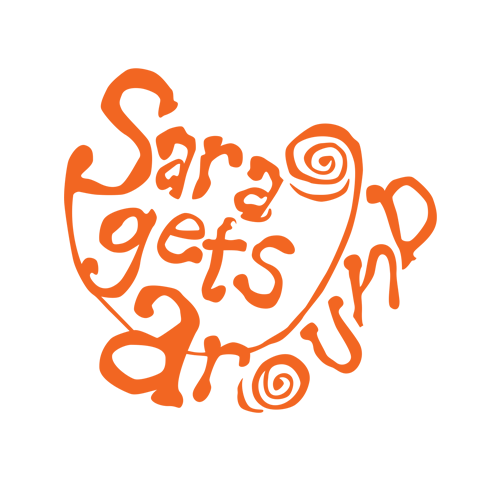
3 Best Amsterdam Bars & Their Stories. Part 1
We are all aware of the reputation that Amsterdam holds; coffeeshops where you can get high and do drugs, the Red Light District with legalized prostitution, large groups of party seeking tourists haunting the streets in the wee hours… When I tell people that I have been to Amsterdam over 30 times and have never once smoked weed there, they look at me like I just grew an extra head. There is SO MUCH MORE! So, let’s start with eating and drinking…(we’ll wait on culture for the sake of temperance).
This is part 1 of my Best Amsterdam Bars series. Bars (also called cafes) were and are different in Europe than they are in the States and so is their history. Originally ale was simply the safest alternative to water as there was no water purification then; you begin making beer by boiling the water. Everyone drank it. Eventually, beer was produced locally by village housewives and then by monasteries spread across The Low Countries. In the 15th century, the usage of hops was invented (many say by the Dutch!) and commercial production methods improved. Eventually Monastic-produced ale slowed and commercial breweries took over and then The Reformation stopped its production altogether. The earliest bars in The Netherlands arrived in Amsterdam and Den Haag in the 1600s but before this there were similar sorts of gathering places. In Europe, a bar is for the whole community. Yes, there are some that are more raucous and are for serious partying, but those are clubs and discotheques. It does not have the stigma that you find in America that grew from our Puritan roots. Consider Pub life in the UK, it’s a place for the whole family. It is similar here. That said, the patrons are all ages, from the youngest to the elderly and it is not strange.
In addition, those working at a bar do not survive on tips alone as they do in the States. They are paid a salary and given benefits. Europeans do not leave big tips, however, if you are very pleased with your service, it is customary to round up your bill to the nearest Euro. Americans tend to feel awkward if they only order a coffee and nothing else. In Europe, the bar employees make the same money regardless, so order what you want and save your tips for your American servers. I am guilty of tipping a bit more, however. It is appreciated.
De Brabantse Aap
I first came to De Brabantse in the late 90s when it was still De Beiaard. I’d sit with my coffee (“een café, alstubleift”) and write in my journal or scribble on a postcard, always choosing “my seat” by the window. They have a very fine food menu (the soups are especially good) and several very high-end beers on tap, namely Belgian. I have a preference for Belgian beer and I am not alone. Families come, individuals, work parties, anyone and everyone. This location has been a bar for at least a few hundred years!
Brabant – technically Noord Brabant – is a region of the Netherlands in the south that borders Belgium. This is not what the name is referring to. At the beginning of the 17th Century a man from Brabant stood by Het Spui (where the bar is) with his Dutch barrel organ, called a draaiorgel in Dutch (these music makers have a unique history and culture. Here is a present-day version sitting close to Kalverstraat in Amsterdam). Jos from Brabant stood by his machine, tip cup in hand, accompanied by his monkey. Both became a fixture in the neighborhood. Jos fast became a loyal visitor to one prostitute named Soete Neel who gifted the monkey a banana on each occasion. This went on for years. One day he noticed her place of business had been abandoned. She had grown to regret her sinful profession and entered De Bekeerde Susters (the reformed sisters) Abbey, which took in remorseful ladies of the night. Jos found out and went into a deep despair, eventually killing himself by jumping off of De Waag (the weigh house, a 14th century building still standing). The monkey stayed behind surviving off the kindness of the locals. Soon drunks and young people began teasing and abusing the monkey so much so that the monkey began his revenge. He climbed up various buildings on the Spui and threw trash at passersby from the rooftop terrorizing the neighborhood. This went on for two years! Eventually, Soete Neel coaxed him down from the roof, using a bunch of bananas, and the monkey became an honorary Sister. You can read more here: https://debrabantseaap.nl/het-verhaal-van-de-brabantse-aap/
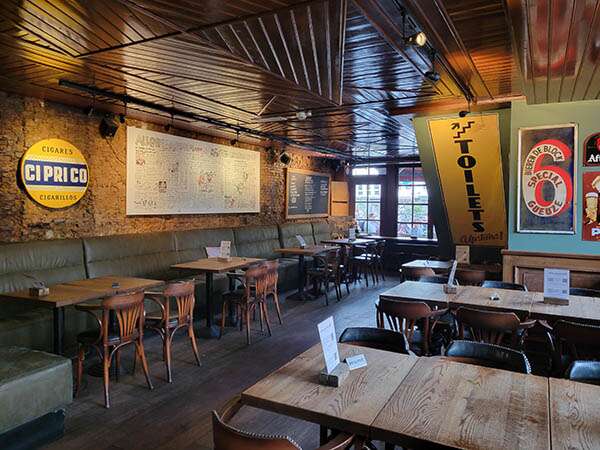
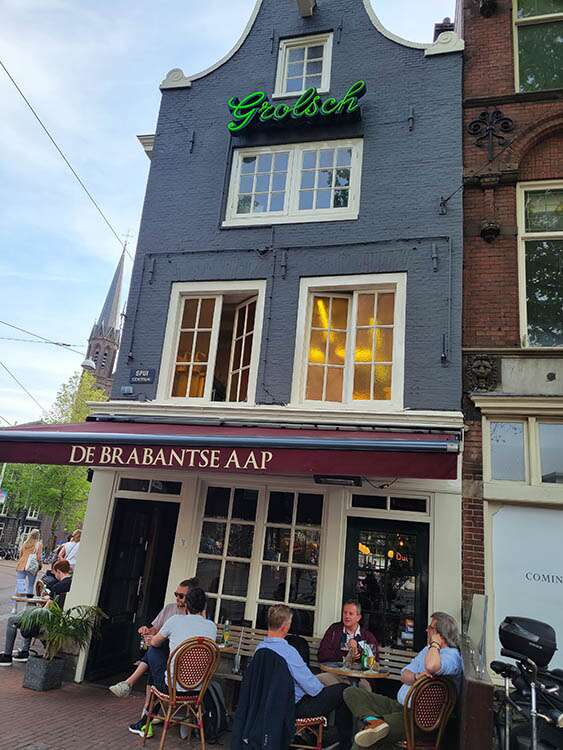
Come here for lunch and come back in the evening for a drink,
there is ample outdoor space to sit outside.
Location and hours:
Spui 30, Amsterdam
Open until 1am and 2am on Friday and Saturdays.
Café ‘t Mandje
All throughout her life, Bet van Beeren (1902-1967) was open about her homosexuality. Being lesbian/gay in Amsterdam was not publicly accepted, but it was decriminalized in 1811; long before any other city. Bet bought her Uncle’s bar when she was 25 and turned it into the only place in town that accepted lesbians and gays. Paris and Amsterdam can boast the earliest bars of this kind. She was already well-known in the neighborhood as a fish vendor, so it didn’t take too long to amass a clientele. She was also a lively character, a skilled story-teller, jokester and singer who could belt out all of the old Amsterdam songs, she also tore through the city on a motorcycle with a girl on her back. She drew people to her naturally.
While homosexuality was technically legal there was no place that openly accepted outward shows of emotion between couples of the same sex. Woman with woman and man with man could now go on proper dates together, hold hands and exchange loving looks without hiding. Bet, however, did not allow kissing (fears about police) nor dancing (she did not have a license), but anything was allowed one day a year; Queen’s Day. Following this open attitude, other less-than-welcomed people (artists, intellectuals, sailors, etc) were also warmly accepted. Beginning in the 1950s, when the police were suspected to be either in the bar or lurking outside, Bet would turn on the light in the porcelain owl in the window to warn people. Because of this, the Dutch word for owl, ‘uil’ now indicates a heterosexual.
Decorating the walls and the ceiling of the bar are momentos from Bet herself and her patrons. She liked when people left souvenirs behind. Several men’s ties hang from the ceiling that Bet collected (or “borrowed”) from her patrons, no one really knows why, I sense that she just liked them. Old Bet-era photographs and posters cover the walls inside beautifully illustrating their unique history. She passed away after 40 years of running the bar. Her body was laid out on the pool table inside the bar for 2 days.
Some may think that lesbian and gay (and trans, etc) specific places are no longer vital to their respective communities. This could not be further from the truth. They need a place special to themselves and others like them, as do most minorities. They need to feel enveloped by their own community, totally safe and free from fear of being shunned regardless of how “accepting” the outside world seems to become, because it is often not the reality.
Café ‘t Mandje remains the same welcoming, festive, old Dutch-feeling place that it always was. Unfortunately during my last visit to Amsterdam it was temporarily closed. (It is now open again!!) It will indeed open again and I hear that they are petitioning the government to raise it to landmark status (they will probably succeed) assuring that it will stay alive for many generations to come!
https://www.cafetmandje.amsterdam
Location:
Café ‘t Mandje
Zeedijk 63, Amsterdam
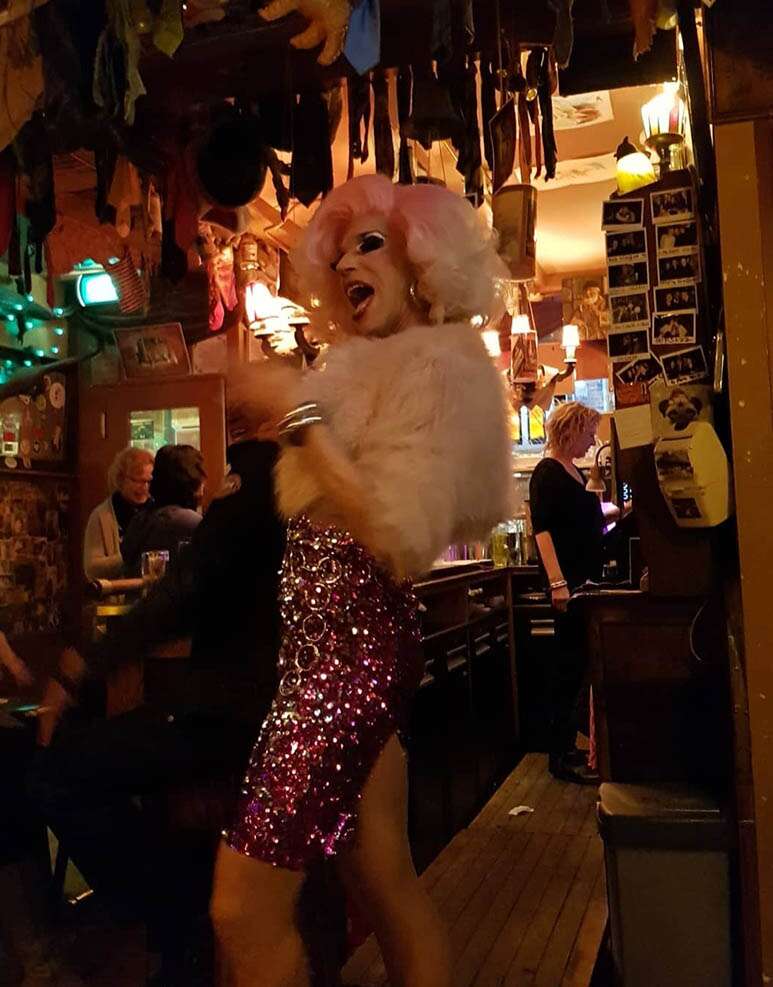
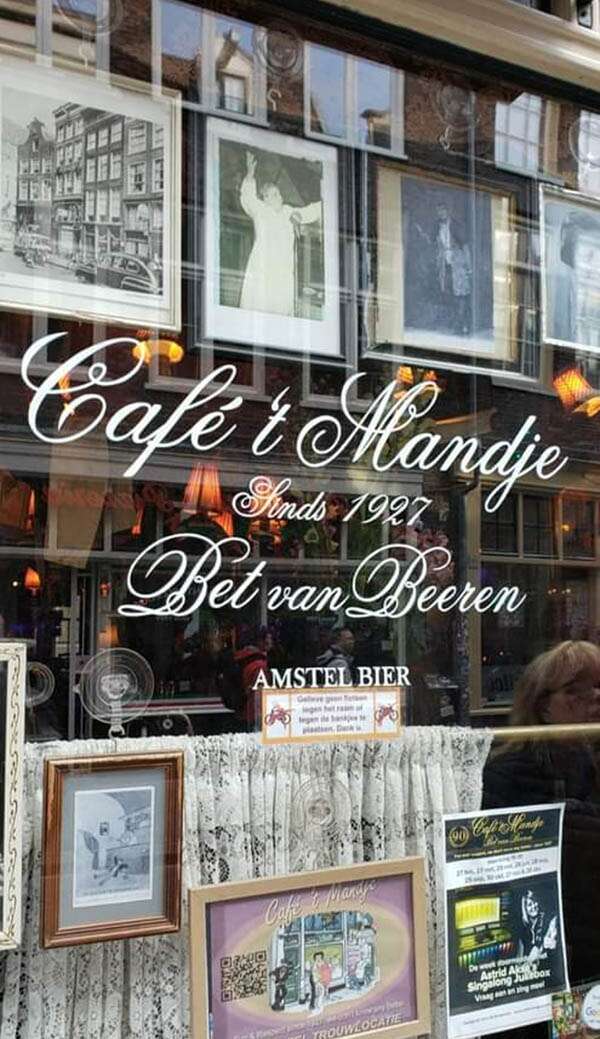
Mulligans Irish Bar
On a typical evening at Mulligan’s I’d show up, sit in my favorite seat and Max, my favorite bartender would lean his elbow on the bar, side-eye me and say: “Can I interest you in a Guinness?” Yes, of course!
I’ve been coming here for years and there is a reason. It is one serious, authentic Irish bar experience. From the décor to the almost nightly Irish music sessions, to the friendly staff and quirky characters; Irish, Dutch and tourists alike, it oozes Irish charm!
Partners – one Irish and one Dutch – opened the place in 1988. At the time, it was heavily frequented by Irish: both local Irish and those summoned over from Ireland to work as laborers on various building projects. It was a place to feel at home, meet others like them and to share and learn about job opportunities, housing and other practicalities. It also attracted various other types of misfits. After this period the Irish patrons were more commonly working in IT (information technology, aka: computer stuff). Later on, when Amsterdam because more touristy, the bulk of the Irish clientele were jolly visitors excited to encounter a slice of home while away. Indeed, everyone is heartily welcomed here! The more the merrier!
During my latest trip to Amsterdam, I met an older man here from Georgia (he in fact grew up in the same house as Fred, the lead singer of the B-52’s! But back to my story…). He bought me a beer before he finished his own. After about 30 minutes his new beer was still full. Max waltzed over, picked it up and said, “I’ll refresh this for you!” And so he did. The Georgia man said to me: “You know Sara, I have gone drinking at a lot of bars in my day, more than I care to admit, and this has never ever happened.”
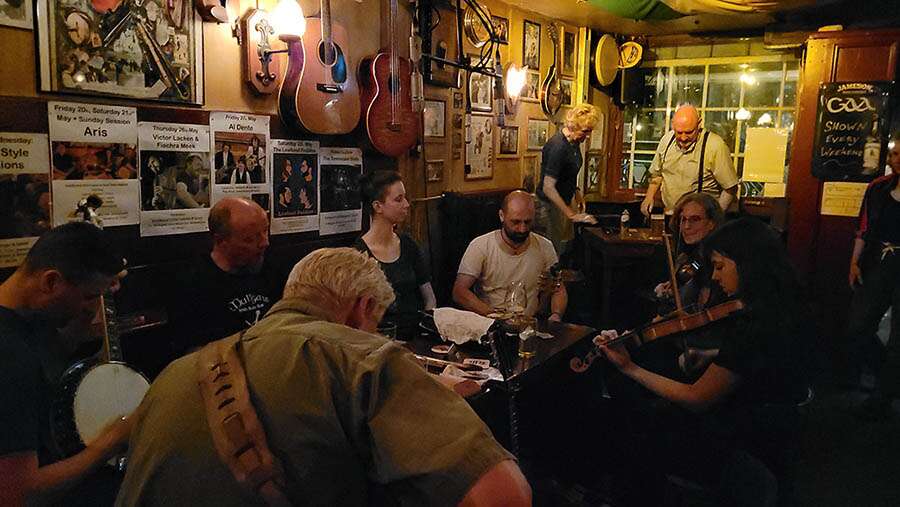
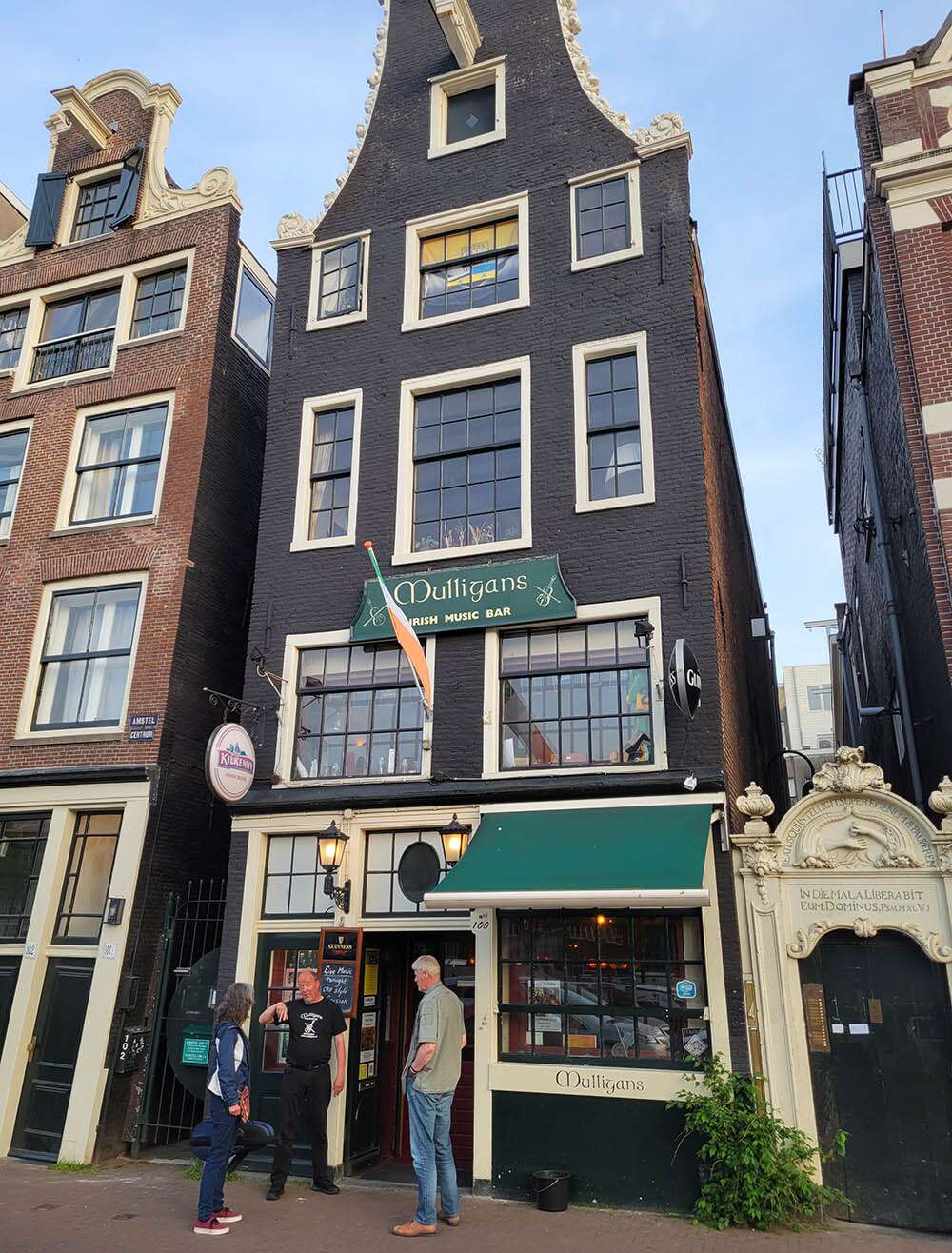
By the front window sits a charming nook with a small table, next to this is a long dining table, this is where the musicians play. You can sit or stand nearby or at the long bar behind the table, there is a back area as well as a separate back room and an upstairs. The walls are tastefully covered with beloved Irish memorabilia; photos, Irish team flags, signs and musical instruments giving you much to look at and enhancing the Irishness.
Irish musicians play live here multiple nights a week and they are even talking about bringing couples dancing to the back room on Thursdays. It is so that musicians in Ireland know of Mulligan’s as a preferred place to perform. Besides Irish music, they also have folk, blue grass and other types. The volume is not so loud that you cannot hear each other talk! You know, the Irish, we can’t shut up. I hope you will take my advice and visit this legendary place! Tell ‘em Sara sent you.
https://www.mulligans.nl/about-us/
Mulligans Irish Music Bar
Amstel 100, Amsterdam
Hours: Open between 2 and 4pm.
Closes at 2am on Friday and Saturday and
At 1am on other nights. Closed Monday & Tuesday.
Check Google, hours may vary.
Part 2 coming soon…
